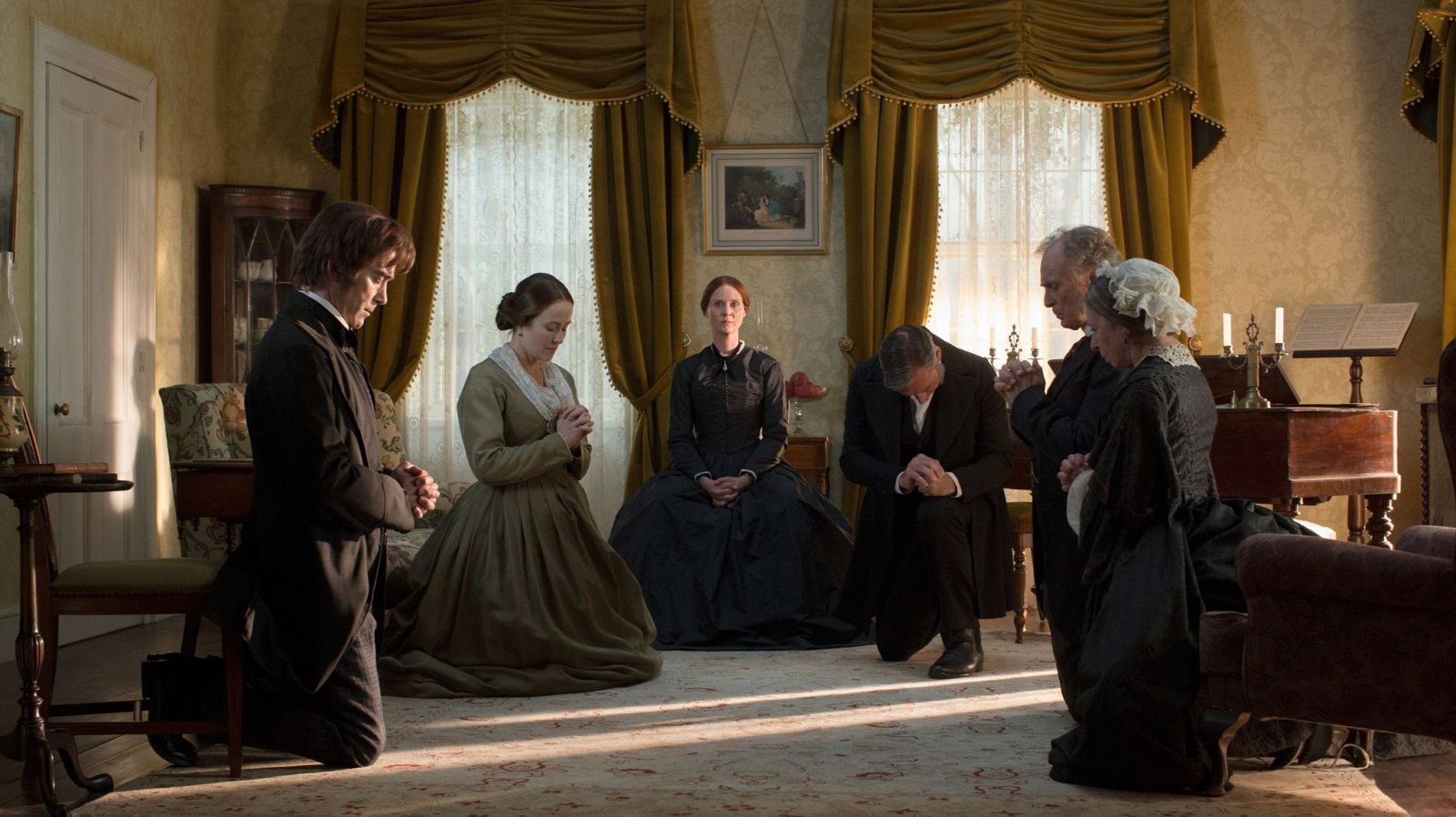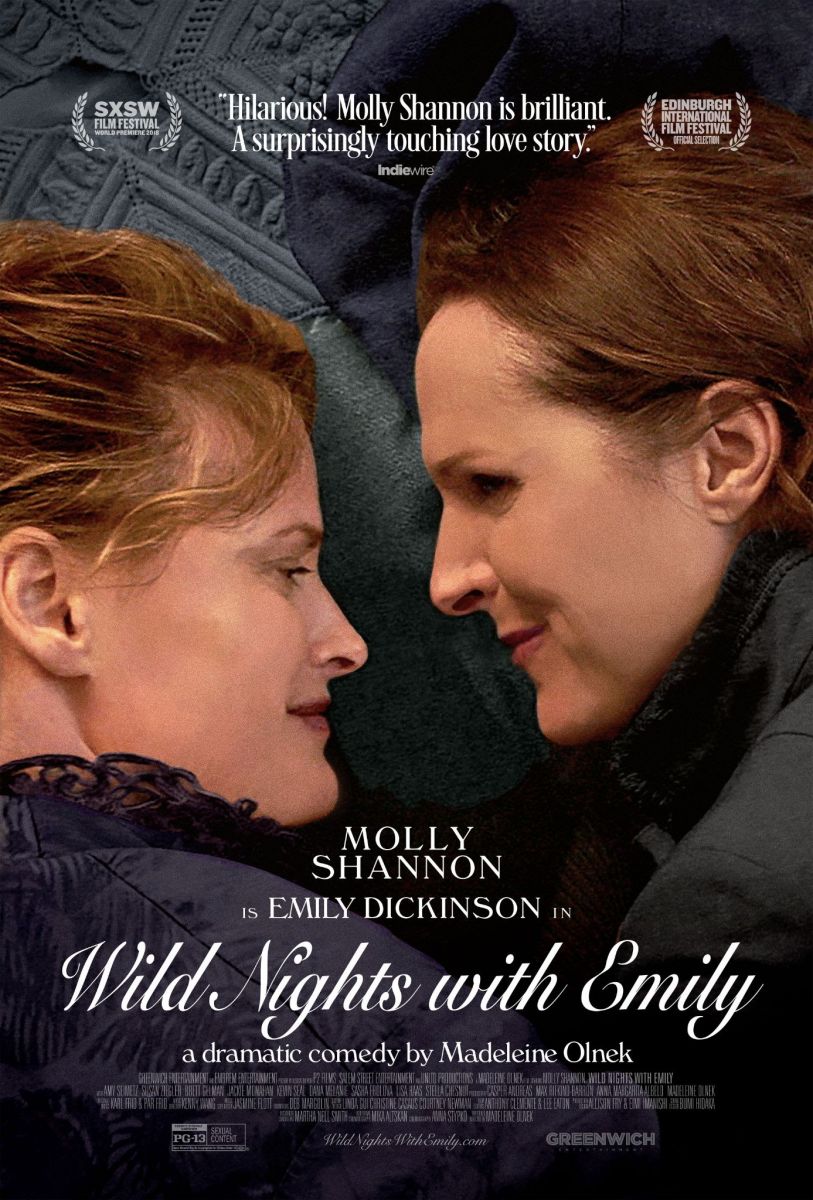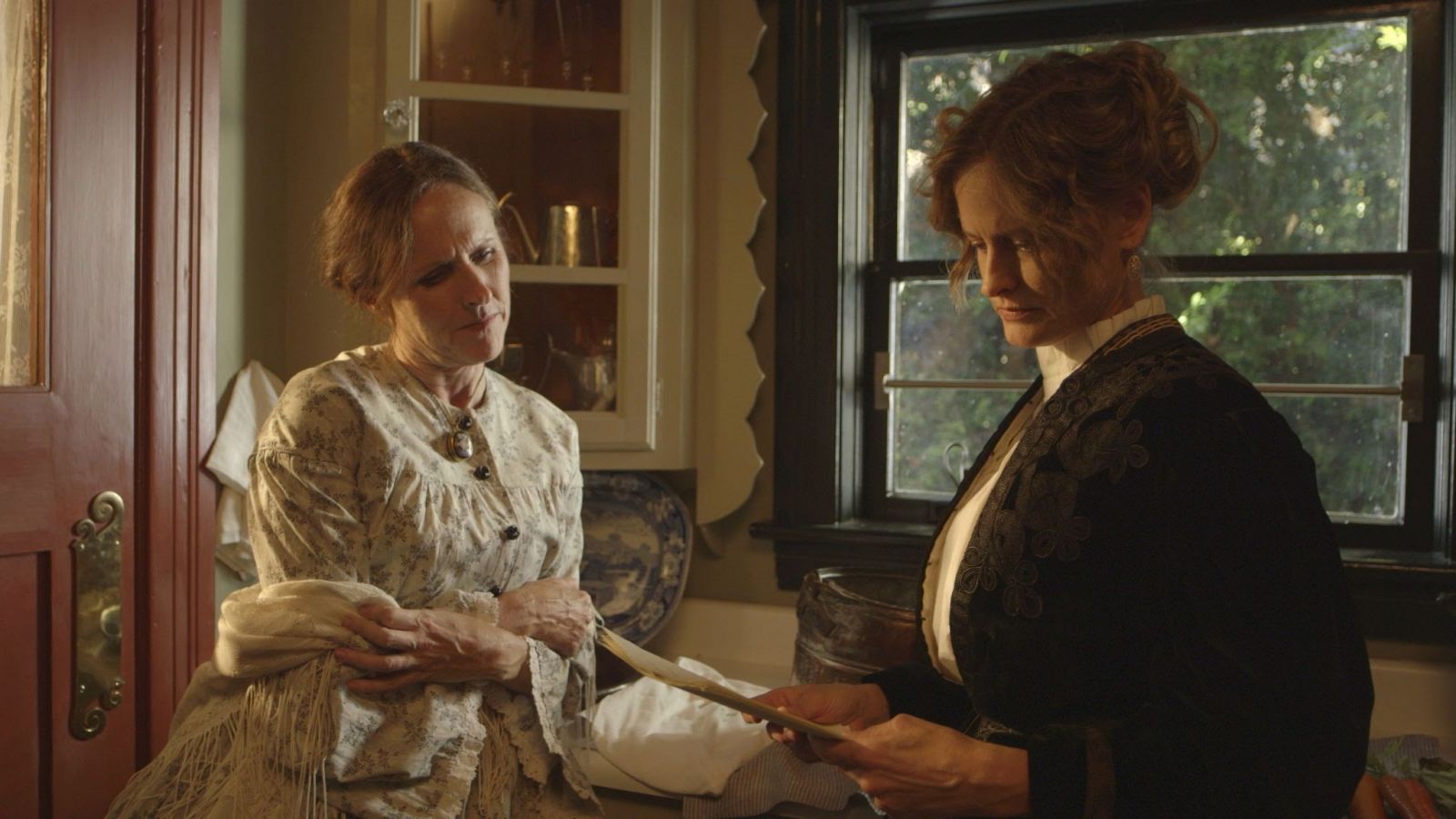- The Ghosts of Emily Dickinson: Hauntings in Popular Culture
- Introduction: Which Dickinson? by Jeannette Schollaert
- Specters on Screen
- Big Reputations: Celebrity and Temporal Duration in/of Dickinson Lyrics by Elizabeth Dinneny
- Ghosts in the Algorithm: The Dickinsons on TikTok by Elizabeth Dinneny
- "Dickinson-core" by Jeannette Schollaert
- Contributors
- Works Cited
"Some keep the Sabbath going to Church -/ I keep it, staying at Home-": Dickinson in Film by Jeannette Schollaert
Released just about a year apart, the two most recent big screen representations of Emily Dickinson could not tell more different stories about Dickinson’s life. In the first movie to be released, 2016’s A Quiet Passion, Cynthia Nixon plays a woman obsessed with the idea of religion and beauty, entirely devoted to her family, who slowly suffers from chronic illness until her early death. In the second, 2018’s Wild Nights with Emily, Molly Shannon plays a sharp and funny Dickinson, ready to laugh with Sue or roll her eyes at the condescension of a male visitor. Both movies have explicit interests: Davies’ drama seeks to explore Dickinson’s religion, and her “quiet passion'' for faith and family through her life. Olnek’s film tells a story of queer erasure, toggling between a lecture after Emily’s death by her first editor, Mabel Loomis Todd, that frames contrarian flashbacks to Dickinson’s lively love with her sister-in-law Sue. Olnek’s argument is most obvious in the final heartbreaking scene, a splitscreen between Sue bathing Emily’s body for burial and Mable efficiently erasing Sue’s name from Emily’s manuscripts, erasures that resulted in the edited versions of Emily’s poems that were canon for so long before archival research proved Sue’s place in Emily’s letters.
Each film offers unique perspectives on Dickinson’s life, specific versions of Emily that inevitably present her in a specific frame that leaves out other aspects – a necessary framing to accommodate the average run time of a film, a constraint not felt by the free-wheeling AppleTV+ television series. The films brought renewed attention to Dickinson scholarship and criticism, especially Wild Nights with Emily, as the film is dedicated to the career of Dickinson scholar and executive director of this site, Martha Nell Smith. Yet the films also helped to inspire research projects like Ivy Schweitzer’s weekly blog White Heat: Emily Dickinson in 1862. As Schweitzer notes in her “ethos of the project” description, she aimed to “embrace serendipity” in her project. She explicitly frames her project as a reaction, in part, to the representations of Dickinson in recent films that “counteract the myth of the quaint recluse removed from the world” (“White Heat). Her project seeks to complicate such readings of Dickinson by resituating Dickinson’s writings from her most prolific year alongside the events and popular culture of that year. Schweitzer’s focus on both national and international events from the year 1862 lend insight to what Dickinson’s atmosphere might have been like, using primary sources and linked documents to directly illustrate her point.
While Schweitzer’s re-grounding of Dickinson within her historical and cultural contexts is undoubtedly important, especially as we continue to consume fictionalized representations of Dickinson’s life and her contemporaries, part of the joy of consuming the films is indulging in the visions of Dickinson each presents. Dickinson as a deeply spiritual but “no-hoper” in a strict nineteenth century religious sense, versus the Dickinson who shared with Sue “the church within our hearts, where the bells are always ringing, and the preacher whose name is Love – shall intercede there for us!” (OMC 15).

Fig. 1. Image Description: Promotional still for A Quiet Passion. Emily sits in the center of the frame, dressed in black. She is surrounded by her family in a half circle, all others knelt in prayer. The family sits in a parlor-like room of the Dickinson Homestead, with yellow wallpaper and dark mustard drapes. From L-R, all kneel in prayer except Emily: Austin Dickinson, Lavinia Dickinson, Emily Dickinson, Pastor, Edward Dickinson, and Emily Dickinson Sr.
The more serious of the two films, A Quiet Passion nevertheless offers moments of brevity that allow Cynthia Nixon to express Dickinson’s sense of humor and imagine her easy laugh. The film’s interest in Dickinson’s religious journey is paired with an exploration of the choices available to women in the nineteenth century. Davies explores the former by depicting Emily’s early rebellion at school, and further through a hint of a romantic relationship between Dickinson and a (male) local reverend. The film’s exploration of the choices available to women uses a fictional friendship between Dickinson and Vryling Buffam to set the stage for conversations about the advantages of marriage. Vryling Buffam was a real woman who lived in Amherst during Emily Dickinson's lifetime, but there is no evidence that the two ever met. The only evidence of Buffam's connection to the Dickinsons is a citation that Buffam sat next to Lavinia Dickinson during the March 1898 lawsuit over a piece of land that Mable Loomis Todd claimed that Austin Dickinson, with whom Mabel was having an affair, supposedly gifted to her (Longsworth 416, 325n). The film creates and enlarges Buffam's role in Emily's life, and Nixon’s Dickinson is devastated when the quick-quipping Buffam marries and leaves town, yet the film strangely misses an opportunity to show Dickinson’s close relationship with her sister-in-law Susan. Davies' decision to create a fabricated role for Buffam is especially curious when viewed alongside Susan's presentation as a complete stranger until the moment of Austin’s marriage. Susan remains a peripheral character for most of the film save one late-night conversation in which Susan expresses her resigned distress at the sexual and domestic expectations of marriage. There are moments of levity in A Quiet Passion – Nixon’s deadpan smashing of a slightly dirty plate is a bright spot – but most of the film is concerned with heavenly destinies more so than Dickinson or her poems, which serve as set dressings via Nixon’s voiceovers in transitional moments throughout the film.

Fig. 2. Image Description: Promotional poster for Wild Nights With Emily, picturing Susan Zeigler as Susan Dickinson to the left, and Molly Shannon as Emily Dickinson to the right. Both women are laying down close together on a navy pillow and quilt. The poster includes information about the film’s production credits at the bottom, including the description of the film as “a dramatic comedy by Madeleine Olnek.” At the top of the post reads a blurb review of the film as well as information about the film’s screenings at SXSW and Edinburgh Film Festival.
Wild Nights with Emily, however, seeks to do something else entirely. By structuring the film as a kind of flashback correcting Mabel Loomis Todd’s lectures to promote her edition of Dickinson’s poems, Olnek’s film essentially speaks back to decades of Dickinson scholarship that echoed the version of Dickinson that Todd constructed to market her book. Olnek’s Todd is not a caricature of an evil villain, but a woman on a mission in a similar spirit to Midori Asahina’s reconsideration of Todd’s role as Dickinson’s first editor. Olnek provides background for Todd’s actions, showing the affair between Todd and Dickinson’s brother Austin in detail in addition to her focus on Emily and Sue. While the structure of the film makes a specific argument about the scholarly manipulation of Dickinson’s life to fit a certain model, the content of the film itself is a romantic comedy of Sue and Emily’s relationship. Before Alena Smith’s twerking Dickinson hooked up with Sue in a dessert fantasy on the dining table of the Homestead, Olnek offers a backstory of Emily and Sue’s love story, beginning with an intimate sleepover and continuing through adulthood, in trysts during Sue’s salons. The light moments of Sue and Emily’s relationship are balanced with the tragedies of the Dickinson family life, from the death of Sue and Austin’s youngest child, Gib, to a complicated attempt at reckoning with the horrors of the Civil War in Emily’s death scene.
It is in the death scenes that both films hit their emotional highmarks. Yet for Davies’ film, it is not Emily’s death that is the most interesting – it is the death of Emily’s mother, Emily Dickinson Sr. One area of Dickinson scholarship that is perhaps understudied is a consideration of Emily and Lavinia’s work as caretakers for their mother.[1] Mrs. Dickinson’s death is peaceful, as she is surrounded by her children – snug in between her two daughters on her deathbed, with her son sitting on a chair nearby. The family sits together, talking to delay the inevitable moment of Mrs. Dickinson’s passing. The film lingers on a shot of Emily, her mother, and Lavinia, as the two daughters' faces change as they feel their mother pass away. Emily’s parents are not as central to Olnek’s film, but the aforementioned scene following Emily’s death is one of the most striking moments of her film. Susan enters the Homestead and is greeted by Lavinia, who asks Susan to wash and prepare Emily’s body for burial. Susan enters the room, and the air leaves the film as she confronts the task ahead. Olnek’s masterful pairing of this tender moment between Sue and a no-longer-there Emily with the quiet scratching of Mabel’s erasures tries to communicate the loss of a century-old erasure of Sue and Emily’s devotion. The “Dear, dead women'' are honored here, as are the ghosts that remain in the shadows of penciled script in their letters to one another.

Fig. 3. Image description: Promotional still from Wild Nights with Emily. Emily (left, Molly Shannon) and Sue (right, Susan Zeigler) stand in a kitchen, in front of open cabinets and a large window, and both look at papers in Susan’s hand. They both consider a draft of Emily’s writing.
Both films were well-reviewed and prompted ample online conversation – A Quiet Passion for Davies’ lyrical depiction of Dickinson and Nixon’s conversations with press about how she believes that a contemporary Dickinson would have a twitter account – a belief that I have my own doubts about, given that Dickinson’s cottagecore aesthetic is more suited to Instagram as a platform (Pulver, “Cynthia Nixon…”). Wild Nights with Emily was met with praise, but also more rigorous interrogation about the historical evidence for its content, a trend that Olnek was quick to critique in an interview with Vulture:
There wasn’t a single review of A Quiet Passion that said, “This is not accurate,” whereas I’ve gotten that a lot: “Oh, what’s this based on?” And really angry responses, like, “She’s making this up,”… “Considering how much time I’ve spent researching this, and considering how many resources that movie had – there’s one movie about Emily Dickinson, and they can’t get it right? I feel like [the real] story has just been hiding in plain sight. (Handler “Behind the New…”)
The demands for evidence Olnek faced from press and reviewers demonstrate an unwillingness for some to relinquish their version of Dickinson – prim, pious Dickinson who stoically bore her isolation and did not experience passionate love, let alone passionate queer love. So many versions of Dickinson went unchallenged, yet Olnek’s version – perhaps the version that most readily cites its evidence in the film itself, via the prominent notice of permissions from Harvard and explicit ties to Smith’s scholarship – faces calls for elaboration and explanation.
Both Olnek's and Davies' films are available to stream, Davies’ on Amazon and Olnek’s on Hulu.
Notes
[1]On this point of reading Emily and Lavinia as caretakers, I am indebted to the discussions for the DEA undergraduate internship group during the spring 2019 semester with E. M. Patterson, Deanna Stephen, and then-co-project manager Setsuko Yokoyama.



